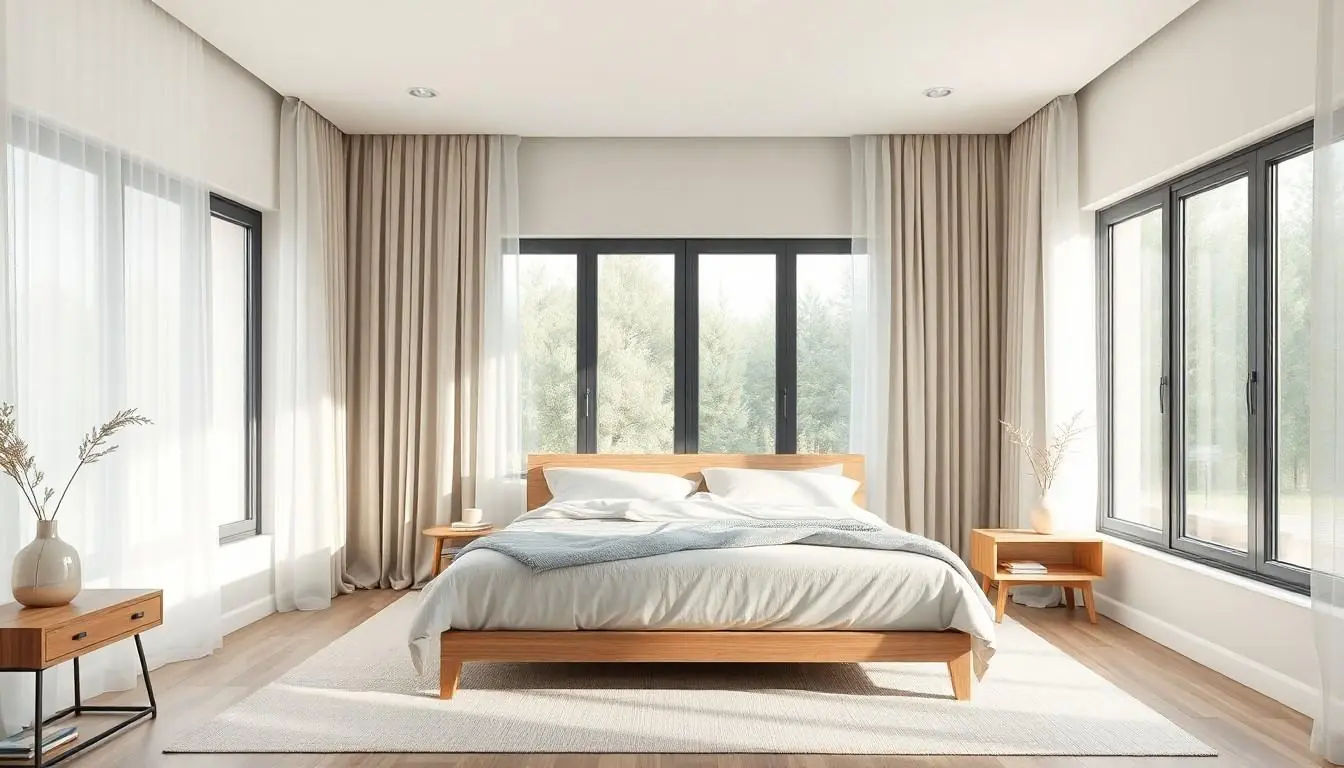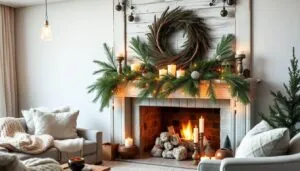In a world bursting with bold colors and extravagant patterns, neutral bedrooms are the unsung heroes of home design. They offer a serene escape from the chaos outside, proving that sometimes less really is more. Imagine stepping into a space that whispers calm instead of shouting for attention—sounds dreamy, right?
Neutral palettes create a versatile backdrop, allowing personal touches to shine without overwhelming the senses. Whether it’s a cozy reading nook or a chic gallery wall, a neutral bedroom invites creativity while maintaining a sense of tranquility. Plus, who wouldn’t want a space that effortlessly adapts to their ever-changing mood? Get ready to transform your sanctuary into a haven of peace and style with the magic of neutrals.
Table of Contents
ToggleOverview of Neutral Bedrooms
Neutral bedrooms create a serene atmosphere that fosters relaxation. By utilizing colors like beige, gray, and soft white, these spaces invite calmness. The choice of neutral tones acts as a versatile canvas, accommodating various interior styles.
Designers often recommend combining different textures to add depth to a neutral palette. Incorporating materials like cotton, linen, and wood introduces an inviting warmth. Accent pieces, such as decorative pillows or artwork, can introduce subtle contrast without disrupting the overall harmony.
Natural light plays a crucial role in enhancing the appeal of neutral bedrooms. Large windows allow sunlight to illuminate soft hues, making the room feel airy and spacious. Choosing sheer curtains or no window treatments can further amplify this effect.
Selecting furnishings in neutral shades can help maintain a cohesive look. Beds, dressers, and nightstands in whites or light woods integrate smoothly into the atmosphere, ensuring a tranquil environment. Layering rugs or throws in similar tones contributes to a feeling of comfort.
Decorative accessories should complement the neutral theme without lagging behind. Simple vases, organic plants, and minimalist decor serve to accentuate the calmness of the room. These elements contribute to a unique yet unobtrusive style.
Neutral bedrooms significantly enhance wellbeing. They provide a retreat from busy lifestyles and allow individuals to unwind. With thoughtful planning, anyone can transform their sleeping space into a tranquil haven, benefiting from the versatility and elegance of neutral design.
Benefits of Neutral Bedrooms

Neutral bedrooms promote relaxation and style, offering several distinct advantages.
Calming Atmosphere
Calm colors like beige, gray, and soft white create a soothing environment. These shades help reduce stress, making them ideal for retreat spaces. Natural elements enhance tranquility, bringing serenity indoors. Soft textures from cotton and linen further add to the calming effect. Large windows allow for ample natural light, which contributes to an airy, open vibe. Light-filtering sheer curtains maintain privacy while keeping the room bright. Altogether, these aspects foster a peaceful haven for rest and unwinding after a busy day.
Versatile Decor Options
Versatility defines neutral bedroom decor, allowing for diverse styles and personalization. One can mix modern and traditional furnishings effortlessly when utilizing neutral palettes. Neutral colors act as a backdrop, emphasizing unique artistic pieces or bold accessories. Layering different textures—such as wood and metal—adds depth without overwhelming the senses. Designers often recommend selecting minimalistic decor, like simple vases or organic plants, that complements the neutral tones. These choices create balanced aesthetics while maintaining a cohesive look. Consequently, neutral bedrooms adapt to individual tastes and changing trends with ease.
Popular Color Schemes
Neutral bedrooms rely on well-chosen color schemes that create a serene environment. Designers frequently recommend these popular options.
Shades of White and Gray
White and gray tones dominate neutral palettes, providing an elegant backdrop. Soft whites promote brightness and enhance natural light, making spaces feel airy. Gray adds depth, creating a balance that complements various decor styles. One can mix shades of gray, from light to charcoal, for subtle variation and visual interest. Pairing these colors with textured fabrics brings warmth and sophistication to the room.
Earthy Tones
Earthy tones, including beige, taupe, and muted greens, ground the atmosphere. These colors evoke a sense of connection to nature and promote relaxation. Incorporating shades like warm taupes or soft greens encourages a comforting vibe. Textured materials, such as woven baskets or wooden furnishings, elevate this earthy scheme by adding dimension. Implementing natural elements through decor enhances the tranquil essence of the space while maintaining a harmonious flow.
Key Design Elements
Neutral bedrooms feature essential design elements that contribute to their calming and inviting atmosphere. Key aspects include furniture selection, textiles, and accessories that align with the overall aesthetic.
Furniture Selection
Selecting furniture in neutral tones plays a significant role in achieving a cohesive look. Sofas and beds in beige, gray, or soft white create a harmonious environment. Keeping furniture lines simple enhances the serene vibe. Incorporating natural materials like wood or rattan adds warmth without overpowering the space. Selecting multi-functional pieces also maximizes practicality while maintaining a minimalist approach.
Textiles and Accessories
Textiles contribute greatly to the comfort of a neutral bedroom. Layering various fabrics such as cotton or linen creates depth and visual interest. Area rugs in muted tones soften hard surfaces and provide warmth. Accessories, like simple vases or organic plants, offer subtle decoration without overwhelming the calming theme. Opting for light-filtering curtains allows natural light to fill the room, enhancing the airy feel essential for a tranquil retreat.
Creating a Neutral Bedroom
Creating a neutral bedroom fosters an atmosphere conducive to relaxation and peace. A thoughtfully chosen color palette serves as a vital first step in this process.
Tips for Choosing the Right Colors
Start with a base of soft whites or light grays to establish brightness. Incorporating warm beige or taupe contributes to grounding the aesthetic. Select muted greens for a subtle connection to nature. Ensure that your color choices enhance the room without competing for attention. Layering different shades within this palette adds depth and richness. Consider how natural light interacts with colors at different times of the day; this influences the overall feel. Test samples on the walls before settling on the final shades, as lighting can change their appearance dramatically.
Arranging Your Space
Begin by selecting furniture pieces in harmonious, neutral tones to maintain a cohesive look. Position larger items like beds and dressers to create an open flow within the room. Aim for balance by pairing heavier furniture with lighter decor elements. Create areas for relaxation using soft textiles and natural materials. Include area rugs to define spaces and increase warmth. Arrange accessories deliberately, allowing each piece to complement the neutral theme without overwhelming it. Collecting decorative items made from organic materials adds touches of life to the serene environment.
Neutral bedrooms offer a serene escape that blends style with tranquility. By incorporating soft colors and natural elements, individuals can create a peaceful haven that promotes relaxation. The versatility of neutral palettes allows for personalized touches while maintaining a cohesive aesthetic.
Thoughtful design choices such as textured textiles and simple furnishings enhance the calming atmosphere. With the right arrangement and decor, anyone can transform their bedroom into a stylish sanctuary that invites rest and rejuvenation. Embracing the beauty of neutral design not only elevates the space but also nurtures overall wellbeing.


